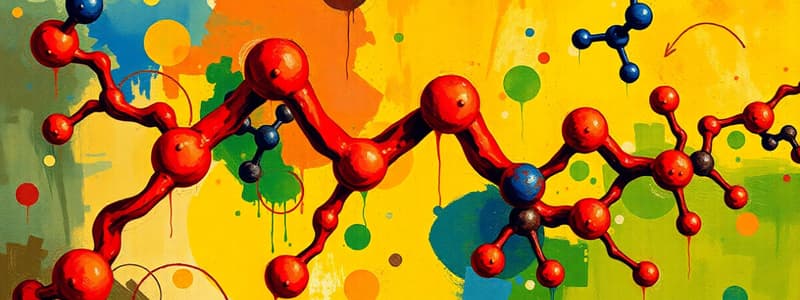Podcast
Questions and Answers
What is the primary function of carbohydrates in the body?
What is the primary function of carbohydrates in the body?
- Building muscle tissue
- Long-term energy storage
- Providing quick energy (correct)
- Carrying genetic information
Which of the following is the monomer of proteins?
Which of the following is the monomer of proteins?
- Nucleotide
- Fatty acid
- Amino acid (correct)
- Monosaccharide
What term describes lipids' inability to mix with water?
What term describes lipids' inability to mix with water?
- Amphipathic
- Hydrophobic (correct)
- Hydrophilic
- Hydrogenated
Which macromolecule is primarily involved in carrying genetic information?
Which macromolecule is primarily involved in carrying genetic information?
What determines the specific function of an enzyme?
What determines the specific function of an enzyme?
What is the main role of hemoglobin in the body?
What is the main role of hemoglobin in the body?
Which type of lipid contributes to heart problems when levels are too high?
Which type of lipid contributes to heart problems when levels are too high?
What forms when an enzyme binds to its substrate?
What forms when an enzyme binds to its substrate?
Flashcards
Macromolecules
Macromolecules
Four main types of large biomolecules: carbohydrates, lipids, proteins, and nucleic acids.
Monomer
Monomer
A smaller subunit that makes up a macromolecule.
Carbohydrate Monomer
Carbohydrate Monomer
Monosaccharide, the simplest form of carbohydrate used for quick energy.
Polysaccharides
Polysaccharides
Signup and view all the flashcards
Lipids
Lipids
Signup and view all the flashcards
Protein Function
Protein Function
Signup and view all the flashcards
Enzymes
Enzymes
Signup and view all the flashcards
Nucleic Acids
Nucleic Acids
Signup and view all the flashcards
Study Notes
Macromolecules
- Four main macromolecules exist: carbohydrates, lipids, proteins, and nucleic acids.
- Also known as biomolecules, organic molecules, or organic compounds.
- A monomer is the fundamental subunit of a macromolecule.
Carbohydrates
- Provide rapid energy for the body.
- Composed of carbon, hydrogen, and oxygen (CHO).
- Carbon, hydrogen, and oxygen are in a 1:2:1 ratio (CH₂O).
- Monosaccharides are the basic units of carbohydrates.
- Glucose is the most common monosaccharide.
- Glycogen is the storage form of carbohydrates in animals.
- Starch is the storage form of carbohydrates in plants.
- Cellulose forms the structural framework of plants.
- Polysaccharides are long chains of monosaccharides.
Lipids
- Functions include long-term energy storage, insulation, and membrane formation.
- Composed of carbon, hydrogen, and oxygen (CHO).
- Lipids have a higher ratio of carbon to hydrogen compared to oxygen.
- Fatty acids are the fundamental units of lipids.
- Phospholipids are essential components of plasma membranes.
- High cholesterol levels can contribute to heart problems.
- Steroids are used in the production of sex hormones.
- Lipids are hydrophobic, meaning they do not mix with water.
Proteins
- Act as the functional molecules within cells.
- Composed of carbon, hydrogen, oxygen, and nitrogen (CHON).
- Amino acids are the building blocks of proteins.
- Hemoglobin transports oxygen in the blood.
- Insulin regulates blood sugar levels.
- Enzymes catalyze chemical reactions.
Nucleic Acids
- Carry genetic information.
- Composed of carbon, hydrogen, oxygen, nitrogen, and phosphorus (CHONP).
- Nucleotides are the fundamental units of nucleic acids.
- DNA and RNA are crucial nucleic acids in biological systems.
Enzymes
- Proteins that catalyze chemical reactions.
- Essential for life, enabling reactions to occur at appropriate speeds.
- Enzymes modify substrates.
- Enzyme-substrate complexes are formed during the reaction.
- Enzymes remain unchanged and reusable throughout the reaction.
Enzyme Facts
- An enzyme's unique shape determines its function.
- The substrate precisely fits the enzyme's active site.
- Enzymes are specific, binding only to a particular substrate.
- Enzymes are reusable, their structure unchanged after the reaction.
- Denaturation occurs if an enzyme's shape is altered, rendering it inactive.
- Denaturation can result from high temperatures or low pH.
- Enzymes reduce the activation energy required to initiate reactions.
- Activation energy is the initial energy needed for a reaction to start.
- Enzymes speed up reactions by decreasing the activation energy needed.
Studying That Suits You
Use AI to generate personalized quizzes and flashcards to suit your learning preferences.



